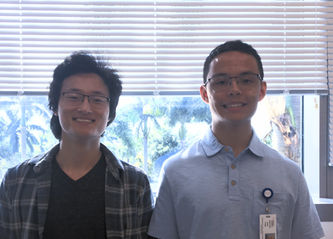In summer 2019, we hosted Jonathan Hung as our 2019 Kenan Fellow on the Scripps Florida campus. For eight weeks, Jonathan worked side-by-side with Eugene (Geno) Joeh, a graduate student on a glycoscience-related project. Jonathan describes his experience in the lab with this (unedited) blog post.

MY SUMMER IN THE HUANG LAB
by Jonathan Hung (Suncoast High School)
August 2nd, 2019
I just wrapped up my presentation explaining what I’ve been doing all summer, which to be honest, looks mostly like figures 1 and 2. This was my day-in, day-out routine, which I suppose I should explain. Without being too technical, my work focused on using a tagging technique to add biotin tags to molecules near a protein called Galectin-3. Some interesting things about this protein: it’s involved in a plethora of diseases, ranging from diabetes and cancer and everything in between; additionally, it interacts not just with other proteins, but sugars (such as lactose)! We were particularly interested in scar tissue formation in the liver, hepatic fibrosis, a precursor to cirrhosis for which there is currently no approved treatment. Also, we are using this biotin-tagging technique to analyze Galectin-3-sugar interactions, something relatively novel. We hoped to see (and saw), that introducing lactose into liver cells would reduce the amount of tagging, and thus the amount of fluorescence since we stained the cells with an antibody that binds biotin. That suggested that in these liver cells, Galectin-3 interactions involved sugars, hooray! There is a lot more, cool stuff to say about these experiments, but this experience was about a lot more than just the science.
The experience as a whole beyond the routine was quite the challenge. Even just trying to wrap my head around the intricacies of the project – the details – was quite difficult and took more time than I expected. The practical work also was very detail-heavy and I stumbled quite a bit along the way. The confidence I had coming in, broke. If anything, what I learned most out of this experience was science is hard, really hard, but it’s also extremely rewarding. Nothing beat the satisfaction of pulling up microscope images and being able to tell a story with them. But along with that satisfaction came a much-needed humility.
That isn’t to say I didn’t enjoy myself. The general atmosphere of the lab was great, and the science was interesting. Working with my mentor, Geno, Mia, and the rest of the lab showed me indeed how human scientists really are, and left me with a great feeling about pursuing science as a career. Overall, the experience was incredible and at risk of being cliché, life-changing, and I am ever grateful for everyone I had the pleasure of working with in the Huang lab for making it so.

Figure 1. Pipetting water into a test tube to prepare a solution.

Figure 2. Imaging cells using a fluorescence microscope.













